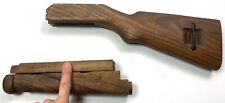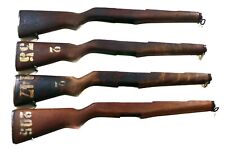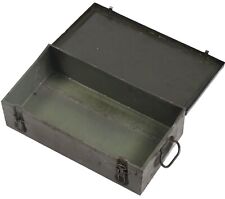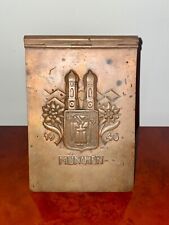|

On eBay Now...
WWII, POST WWII, OCCUPATION, UNIFORM, 325th GLIDER INFANTRY REGIMENT, CAPTAIN For Sale

When you click on links to various merchants on this site and make a purchase, this can result in this site earning a commission. Affiliate programs and affiliations include, but are not limited to, the eBay Partner Network.

WWII, POST WWII, OCCUPATION, UNIFORM, 325th GLIDER INFANTRY REGIMENT, CAPTAIN:
$1145.00
WWII, POST WWII, OCCUPATION, UNIFORM, 325th GLIDER INFANTRY REGIMENT, CAPTAIN, VINTAGE
U.S. Army, WWII, 82nd Airborne Division, 325th Glider Infantry Regiment, Pilot, Uniform Jacket with all original insignia intact. Jacket: Taylor made, four button, four pocket front. Waist belt with brass buckle and snap closure. Made by Fromby Clothing Company, San Antonio. Small moth nip on the upper right lapel. Unmarked size, unnamed. All buttons are intact and are original for this time period. The breast pockets are snap enclosures. The waist pockets have button closures. Otherwise, this jacket is in fine condition. Insignia: Captain Bars: Pinbacks, Hallmarked “STERLING”. The clutch back fasteners are intact and date from the 1940’s. 325thCollar Insignia: Clutch backs. The clutch back fasteners are intact and date from the 1940’s. The numerals 325 are affixed directly onto the top bar of the insignia which is correct for WWII. Matched set, originals. U.S. Collar Insignia: Clutch backs. The clutch back fasteners are intact and date from the 1940’s and are hallmarked “AMCRAFT” Presidential Unit Award: Pinback 82ndAirborne Patch and Airborne Tab: Cut edged. The Airborne Tab was hand stitched to the left shoulder. 325thGlider Infantry Para Oval; This oval is a late WWII to Occupation, U.S. Army, on dark blue felt background. Silver edge. This style saw widespread use by the unit during its days as an occupation force in Germany. It is belief that this variation was made specifically for the 325thGlider Infantry Regiment. Glider Badge: Pinback, Hallmarked “STERLING” Ribbons: PH with Bronze Oak Leaf Ribbon Army of Occupation Ribbon European African Middle Eastern Campaign with Bronze Arrowhead and 3 Bronze Oak Leaves, Ribbon American Campaign Ribbon WWII Victory Ribbon Combat Infantry Badge Clutch backs. The clutch back fasteners are intact and date from the 1940’s. After WWI the colors of the 325th Regiment were cased but were to be unveiled once again on March 25, 1942 under the command of Colonel Claudius Easley.Located at Camp Claiborne, Louisiana,the Regiment was again to be part of the 82nd Division.Late in July 1943, the heavy equipment arrived that would turn the regiment into the 325th Motorized Infantry Regiment. This suddenly changed when the Chief of Staff, General Marshall had decided that the 82nd Division would be an excellent division to use as a base for his proposed Airborne force.General Omar Bradley, because of his excellent work in training the 82nd Division, was to be transferred to the 28th Division which was having a great deal of trouble in meeting its training objectives. General Matthew Ridgway, the 82nd Assistant Division Commander, would become its Commander. The 325th Glider Infantry Regiment was formed and given the task of arriving into battle by glider.Parachutes could, and often did, wind up scattered for miles on a drop zone.The same held true for equipment and supplies.The glider was the answer to all these problems.As long as a glider stayed in one piece,the items inside it would too.This meant no more searching through the swamp looking for the missing barrel to a Howitzer.Jeeps could also fit into a glider.Best of all, troops could be put into a glider and land as a coherent fighting unit. Gliderborne assaults, however, were not without their risks.Gliders and their tow planes were slow, fat targets.They had no armor to protect the men inside.Landing in a glider was also an adventure and little more than a controlled crash.Even if the pilot had the time and altitude to select a good spot to land, conditions on the ground of which he might be totally ignorant could wreck a landing.Ditches, wire, fences, tree stumps or a host of other possible ailments could flip, twist, or gut an unfortunate glider. During the time of its introduction to the gliders, the Regiment lost its Commander.Colonel Easley was promoted to Brigadier General and went to the 96th Division.He was replaced by Colonel Harry Lewis who would guide the Regiment through its glider training and on to combat overseas. The 325th Glider Infantry Regiment was formed and given the task of arriving into battle by glider.Parachutes could, and often did, wind up scattered for miles on a drop zone.The same held true for equipment and supplies.The glider was the answer to all these problems.As long as a glider stayed in one piece,the items inside it would too.This meant no more searching through the swamp looking for the missing barrel to a Howitzer.Jeeps could also fit into a glider.Best of all, troops could be put into a glider and land as a coherent fighting unit. Salerno: The Regiment arrived to its first battle, not by air, but by sea.Boarding beach landing craft, the Regiment was sent to Salerno from the island of Sicily to reinforce American units already there.On September 15th at about 2300, they landed at Paestum, some eighteen miles south of Salerno where they awaited orders.Daybreak on the 16th brought orders.The 2nd Battalion was to re-board the landing craft and farther north to the town of Maiori.Here they were to be attached to Colonel William O. Darby's Ranger Task Force and relieve Ranger units currently holding positions on 4000 foot Mount St. Angelo di Cava.The Battalion was welcomed the next morning by a German artillery barrage.The Germans probed the Battalion lines.Despite numerous attempts to throw the Glidermen off the mountain, the Americans held their ground.It was here that the Regiment received its first casualties of the war. Normandy - D-Day: On 7 June 1944, D-Day plus one, the Regiment landed by glider in Normandy and participated in the invasion of France. On 9 June, Private First Class Charles N. Deglopper single-handedly defended his platoon's position and subsequently was awarded the Medal of Honor for this action. As soldiers of the 325th Glider Infantry Regiment swooped down to Normandy, other elements of the 82nd Airborne Division were in the process of capturing the town of St. Mere Eglise on an airborne operation behind enemy lines. It was for the success of their effort that the soldiers of the 82nd Airborne Division were awarded the red and green braided French Fourregerre. The next glider assault for the 325th was during Operation Market Garden, the largest airborne operation ever conducted.During this battle, the 325th landed among German positions that had surrounded other elements of the 82nd Airborne Division. This glider attack turned the tide of battle and earned the Regiment the Distinguished Unit Citation. The Ardennes - Battle of the Bulge Suddenly, on December 16, 1944, the Germans launched a surprise offensive through the Ardennes Forest which caught the Allies325th GIR Company K completely by surprise. Two days later the 82nd joined the fighting and blunted General Von Runstedt's northern penetration in the American lines. Originally, the 82nd Airborne was to defend Bastogne but the 101st Airborne drew that assignment and the 82nd was sent north to Werbomont. The 325th dug in around the crossroads at Baraque de Fraiture and held. During the intense fight in December 1944 The 325th decimated two German Divisions.
The fight continued into January 1945. Absorbing heavy casualties the 325th continued on to Thier-du-Mont.Later in 1945, the 325th's action in Germany ended with the Regiment driving deep into the heart of Germany.The war offically ended in Europe on 5 May 1945 and the 82nd Airborne Division was called upon to serve as the occupation force in the American Sector of Berlin.Here the 82nd Airborne Division earned the name, "America's Guard of Honor." The regiment assisted in Berlin occupational duties until it returned to the United States in 1946 and was deactivated on December 15, 1947.


POST WWII KOREAN VIETNAM WAR FRENCH MAS RIFLE 49 & 49/56 BUTTSTOCK STOCK SET $254.96

Authentic Italian Import US WW2 M1 Garand Wood Stock FMA WWII Post War Rifle $64.95

German WWII / Post WWII Bundeswehr First Aid Box / Ammo Box West Germany WW2 $94.75

WWII-Post WWII Imperial Japanese Currency MULTIPE NOTES OF EACH $148.00

Post WWII/2 USAF CPT BULLION rank bars pair on USAF grey material $19.99

POST WWII, 1948-2000, U.S. NAVY AIRCREW SURVIVAL EQUIPMENTMAN, RATES, GROUP OF 5 $20.00

RARE Post-WWII Germany 1946 'MUNCHEN' Copper Munich German Note Pad Cover $299.99

Large Lot WWII and Post WWI Patches Insignias Collection 189+ with Guide $1349.99
|